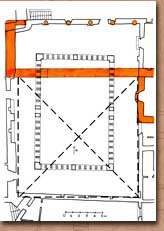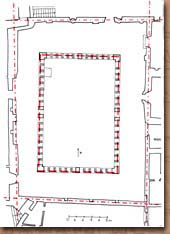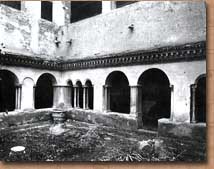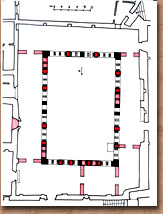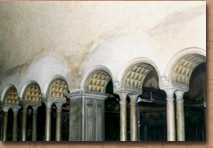Historical survey and investigations: conclusions
edited by Lia Barelli
During the months of October and November further research was carried out in order to improve knowledge of the characteristics of the cloister. Bibliographic, archival and iconographical research has provided several pieces of valuable information; in particular, numerous photographs from the beginning of the century have been identified that when matched with the documents relating to Antonio Muñoz's 1913-1916 restoration works conserved in the state archives, have made it possible to reconstruct its extent and the sequence of its operational phases.
The discovery of a comprehensive survey has been fundamental to understanding the history of the cloister, which includes not only the latter but also the structures immediately adjoining it. From the information provided by the survey and from the analysis of the walls visible today, it turns out that the building fabric surrounding the cloister was constructed at different times and sections of it incorporated the Roman and Carolingian structures.
The first cloistered space on an approximately square plan was probably created when the left aisle of the Carolingian basilica was still in existence. Subsequently, perhaps precisely on the construction of the present cloister, the aisle was demolished. The cloister was then extended over an area on a trapezoidal plan whose irregularity was due to the fact that the majority of the perimeter buildings were still in existence. The medieval builders however made a number of shrewd calculations in building the complex: the columned sides that overlook the central garden form an almost perfect rectangle in plan, which when observed from the center, give the impression of a regular space.
It seems that almost none of the original intonaco that covered the walls of the cloister has survived, apart from the traces that were indicated by Antonio Muñoz and those that form part of the fresco decoration on the underside of two arches. The present decoration on the underside of the other arches, as with the majority of the intonaco, dates back to Muñoz's intervention. It is probable that also the marble areas, columns and pilasters were originally colored, though further studies must be made in order to confirm this.
During the survey it was possible to identify the parts that have been radically transformed over time. The main alterations concern the small arches and the coupled columns that support them. At the end of the 16th. century, larger arches were constructed to replace the medieval ones. In order to create a harmonious rhythm the new arches were constructed replacing the former with pilasters obtained by blocking the small arch situated between the two couples of columns and removing the couple that remained between the new supports. The pilasters of the upper galleries were then constructed on the same axis as these new pilasters and perhaps the barrel vaults that cover the corridors were made at the same time. This was the state of the cloister at the beginning of the 20th. century, as the photographs discovered in the archives confirm. It seems that all the external surfaces had been roughly re-plastered altering the original aspect and pink coloring of the arches, as well as the columns.
The Superintendent Antonio Muñoz started to take an interest in the cloister in 1906 when it was still closed to the public. Realizing its artistic and historical importance, he succeeded in having it opened to the public. In 1913, he began the difficult work of restoring at least the lower part to its original form, but did not touch the late Renaissance additions. The elements that were replaced or reconstructed emerged from the survey. Many of the columns with their relative bases and capitals were reconstructed ex novo in the same style. The deterioration into which the cloister had precipitated made it almost impossible to distinguish the original elements from the restored, the latter often only recognizable today thanks to advanced analysis techniques. The smaller arches that had been destroyed to make way for the later ones were renewed and the contour lines of the arched lintels were all restored with new intonaco. Also most of the interior walls appear to have been re-covered with cement-based intonaco, which certainly took place during this phase of the work. Many of the cosmatesque mosaics of the cornice overhanging the small arches were integrated with new elements.
Finally Muñoz arranged for a new color to be put on all the surfaces, which is, in fact, the present one. He positioned numerous archeological pieces on the walls that he himself had discovered, some cemented into the wall, others attached with metal clips. The pieces displayed today were almost all put in the cloister during his restoration work, with few exceptions that can possibly be identified through studying the archives and comparing photographs of the period, as well as analyzing the various methods of attachment.
Work during the Seventies has seen the reconstruction of the intonaco in the upper gallery, the restoration of the wooden roof structures and a new arrangement of the central garden with porphyry block paving surrounding triangular flower beds.
From these studies indications have emerged concerning what tests must be done in order to complete the overall reconstruction picture. These will carried out in the next few months.
|
©
1999 Coordination Monica Morbidelli |
|
Fig. 1 - Reconstruction hypothesis of the original cloistered space: in orange, the structures of the Carolingian basilica.
Fig. 2 - Alignment of the walls in the cloistered space: dotted lines indicate the walls before the construction of the cloister; in red-line shading, the rectangle formed by the external walls of the corridors.
Fig. 3 - The cloister in 1913 (by A. MUÑOZ, Il restauro della chiesa e del chiostro dei Ss. Quattro Coronati, Rome, 1914).
Fig. 4 - Reconstruction plan of the cloister in 1913 before the restoration work by Antonio Muñoz: in black, the medieval elements; in red, the Renaissance pilasters and subsequent modifications in red-line shading.
Fig. 5 - Detail of the painted underside of the arches. |
|
|
|
|
|
|
|
|
|
|
|
|
